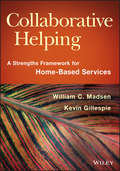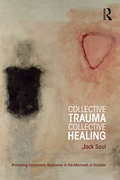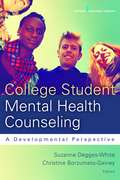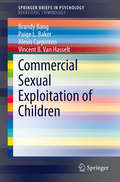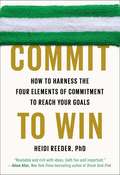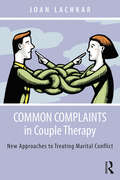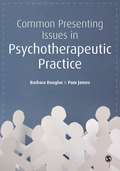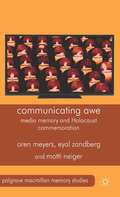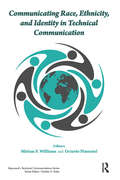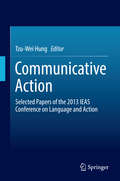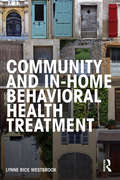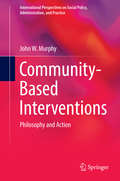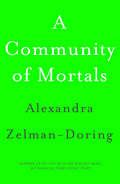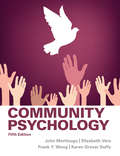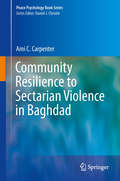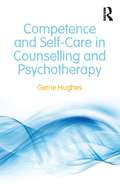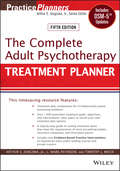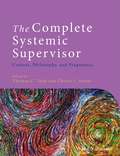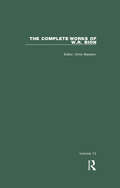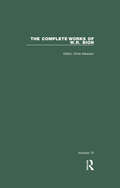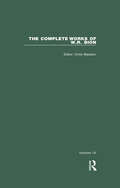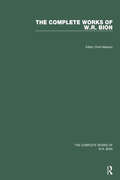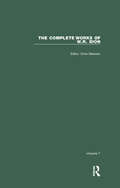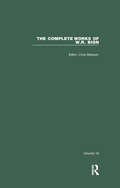- Table View
- List View
Collaborative Helping: A Strengths Framework for Home-Based Services
by William C. Madsen Kevin GillespieAn interdisciplinary framework for sustainable helping through cross-system collaborationThis hands-on resource provides clear, practical guidance for supportive service professionals working in a home-based environment. Drawing on best practices from a range of disciplines, this book provides a clear map for dealing with the complex and often ambiguous situations that arise with individuals and families, with applications extending to supervision and organizational change. Readers gain the advice and insight of real-world frontline helpers, as well as those who receive care, highlighting new ways to approach the work and re-think previous conceptualizations of problems and strengths. Helping efforts are organized around a shared, forward-thinking vision that anticipates obstacles and draws on existing and potential supports in developing a collaborative plan of action.The book begins with stories that illustrate core concepts and context, presenting a number of useful ideas that can reorient behavioral services while outlining a principle-based practice framework to help workers stay grounded and focused. Problems are addressed, and strength-based work is expanded into richer conversations about strengths in the context of intention and purpose, value and belief, hopes, dreams, and commitments. Topics include:Contextual guidance with helping mapsEngaging people and re-thinking problems and strengthsDilemmas in home and community servicesSustainable helping through collaboration and supportA strong collaboration between natural networks, communities, and trained professionals across systems creates an effective helping endeavor. Ensuring sustainability may involve promoting systems change, and building institutional supports for specific supervisory, management, and organizational practices. Collaborative Helping provides a framework for organizing these efforts into a coherent whole, serving the needs of supportive services workers across sectors.
Collective Trauma, Collective Healing: Promoting Community Resilience in the Aftermath of Disaster (Psychosocial Stress Series)
by Jack SaulCollective Trauma, Collective Healing is a guide for mental health professionals working in response to large-scale political violence or natural disaster. It provides a framework that practitioners can use to develop their own community based, collective approach to treating trauma and providing clinical services that are both culturally and contextually appropriate. Clinicians will come away from the book with a solid understanding of new roles that health and mental health professionals play in disasters—roles that encourage them to recognize and enhance the resilience and coping skills in families, organizations, and the community at large. The book draws on experience working with survivors, their families, and communities in the Holocaust, postwar Kosovo, the Liberian civil wars, and post-9/11 lower Manhattan. It tracks the development of community programs and projects based on a family and community resilience approach, including those that enhance the collective capacities for narration and public conversation.
College Student Mental Health Counseling: A Developmental Approach
by Suzanne Degges-White Christine Borzumato-GaineyUsing a unique developmental focus, this clinical handbook provides college counseling professionals and trainees with strategies for addressing the most pressing and frequently encountered issues presented by college students. These problems are considered from the perspective of biological, psychological, and social development and include issues faced by the student population according to both college year (freshman, senior, etc.) and the academic calendar, such as spring and winter breaks and exam periods. The text also addresses the particular needs of non-traditional students and the impact of cultural identity on the way in which a disorder manifests or is best treated. <p><p> The only text to focus on both the developmental and clinical concerns of contemporary college students, it provides detailed information on such prevalent presenting issues as major depressive disorder, anxiety, substance abuse and addiction, eating disorders, grief, self-injury, social adjustment concerns, and intimate relationships. The text examines how a disorder usually presents and manifests in college students, addressing the role of gender, cultural identify, and age. It provides best practice treatment strategies that take into account the time-limited nature of treatment in most college counseling centers, and discusses the use of individual and group counseling. The text also addresses such issues as crisis management, teaming up with faculty and staff to develop preventive care programming, and developing alliances with parents. Case studies and descriptions of symptom presentation are derived from composites of students treated by the authors. College Student Clinical Mental Health Counseling will be useful as both a text and a "go-to" reference for counselors to use when working with students.
Commercial Sexual Exploitation of Children (SpringerBriefs in Psychology)
by Brandy Bang Paige L. Baker Alexis Carpinteri Vincent B. Van HasseltThe commercial exploitation of children is a global crisis (Rahman, 2011; Svensson, 2006). However, media outlets and sociological researchers have successfully situated the problem as a primarily Asian, South American, or Eastern European concern. In the process, the exploitation of children in the United States has largely been ignored. The continued trafficking of international youth into this country, coupled with the growing rate at which American born children are targeted by interstate sex traffickers, speaks to the urgency with which the domestic exploitation of children must be addressed (Walker-Rodriguez & Hill, 2011). In fact, research suggests that an average of 250,000 American children and adolescents are at risk of commercial exploitation each year (Estes & Weiner, 2001). Further, there are indications that current data vastly underestimate the actual numbers of vulnerable and victimized youth (Chase & Statham, 2005). According to the U. S. Department of Justice (2007), no systematic efforts have been made to examine the commercial exploitation of children in this country. The low visibilities of the crime, combined with the inherent vulnerability of the victims, have facilitated the continued victimization of these children. The purpose of this book is to provide a critical analysis of the domestic, commercial exploitation of children. A careful explanation of the differing forms of commercial exploitation of children, victim and offender characteristics, and the mechanisms which maintain the problem will assist health care providers, researchers, and law enforcement in their efforts with this marginalized and understudied population. The authors begin with a comprehensive review of extant literature in this area. Additionally, case studies of child sexual exploitation are included to further illustrate the severity, complexity, and depravity of commercial exploitation in real life cases.
Commit to Win
by Heidi ReederWhat do you need besides motivation and willpower? In Commit to Win, Heidi Reeder, PhD, unpacks over forty years of research by psychologists and economists to show that the key to reaching any goal, whether it's to hit the gym more often or to finally quit that dead-end job, isn't motivation, willpower, or determination. It's commitment. Busting the myths most of us believe about commitment, Reeder shows that it all comes down to four variables: Treasures: the benefits we get from working toward a goal, Troubles: the difficulties we have to deal with, Contributions: the time, money, and effort we invest, and Choices: the number of good alternatives we have. Together, these variables make up a formula that not only measures how committed we are, but also shows which factors we can change to get our commitment level in sync with what we want to do. Packed with practical examples and action plans for a variety of situations, Commit to Win will allow readers to stop wishing for things to be different and instead make practical changes that will naturally empower them to reach their goals. It will appeal to readers of Succeed and The Willpower Instinct.
Common Complaints in Couple Therapy: New Approaches to Treating Marital Conflict
by Joan LachkarMarriage and couple therapists see clients with broken relationships and bonds all the time; those who were once madly in love can grow indifferent, people change, and couples go into sessions feeling depressed, traumatized, and sometimes abused by their partners. Joan Lachkar examines the vicissitudes of love relations by taking into account aspects of aggression, cruelty, sadism, envy, and other primitive defenses lurking in the shadows of love and intimacy. Each chapter revolves around a specific situational conflict, with guidelines and treatment suggestions offered to the therapist. Numerous vignettes and detailed descriptions of theoretical technique, methodology, and diagnostic distinctions are included throughout the book to help readers see theory in action. The theoretical concepts drawn on include psychoanalysis, object relations, self-psychology, attachment theory, DBT, mindfulness, and others, with a heavy emphasis on listening and non-verbal and verbal communication throughout.
Common Presenting Issues in Psychotherapeutic Practice
by Barbara Douglas Pam JamesLearning how to work effectively with a broad range of clients and their presenting issues is a vital part of a career as a therapist, but engaging with the often conflicting worlds of descriptive psychopathology and the subjective meanings of the therapist and client is a real challenge for trainees. They have to develop the skills and knowledge that allow both approaches - one medical, one humanistic - to work successfully together. With the support of expert contributors, Pam James and Barbara Douglas help your students to confidently do just that, proving a comprehensive introduction to the theory, research and practice behind a range of common presenting issues. Key issues covered include: - Anxiety - Depression - Trauma - Bipolar disorder - Psychosis - Eating disorders - Borderline personality disorder This book should be on the desk of every counselling, psychotherapy and counselling psychology trainee, and is recommended reading for other practitioners of health and social care working with these common presenting issues.
Communal Functions of Social Comparison
by Zlatan Križan Frederick X. GibbonsThe extent to which we see ourselves as similar or different from others in our lives plays a key role in getting along and participating in social life. This volume identifies research relevant to such communal functions of social comparisons and summarizes and organizes this research within a single, coherent conceptual framework. The volume provides an important addition to current thinking about social comparison, which has often neglected communal and affiliative functions. Whereas human desire to compare with others has traditionally been viewed as motivated by self-centered needs such as self-evaluation, self-enhancement, and self-improvement, this book presents an eclectic cross-section of research that illuminates connective, cooperative, and participatory functions of social comparisons. In this vein, the book aims both to expose research on currently neglected functions of social comparisons and to motivate a broader theoretical integration of social comparison processes.
Communicating Awe: Media Memory And Holocaust Commemoration (Palgrave Macmillan Memory Studies)
by Motti Neiger Oren Meyers Eyal ZandbergOffering a cross-media exploration of Israeli media on Holocaust Remembrance Day, one of Israel's most sacred national rituals, over the past six decades, this fascinating book investigates the way in which variables such as medium, structure of ownership, genre and targeted audiences shape the collective recollection of traumatic memories.
Communicating Race, Ethnicity, and Identity in Technical Communication (Baywood's Technical Communications)
by Miriam F. Williams Octavio PimentelThe purpose of this book is to move our field's discussion beyond issues of diversity in the practice of technical communication, which is certainly important, to include discussions of how race and ethnicity inform the production and distribution of technical communication in the United States. Equally important, this book is an attempt to uncover those communicative practices used to adversely affect historically marginalized groups and identify new practices that can be used to encourage cultural competence within institutions and communities. This book, like our field, is an interdisciplinary effort. While all authors have taught or practiced technical communication, their backgrounds include studies in technical communication, rhetoric and composition, creative writing, and higher education. For the sake of clarity, the book is organized into five sections: historical representations of race and ethnicity in health and science communication; social justice and activism in technical communication; considerations of race and ethnicity in social media; users' right to their own language; and communicating identity across borders, cultures, and disciplines.
Communicative Action: Selected Papers of the 2013 IEAS Conference on Language and Action
by Tzu-Wei HungThis book focuses on the connection between action and verbal communication, exploring topics such as the mechanisms of language processing, action processing, voluntary and involuntary actions, knowledge of language and assertion. Communication modelling and aspects of communicative actions are considered, along with cognitive requirements for nonverbal and verbal communicative action. Contributions from expert authors are organised into three parts in this book, focussing on language in communication, action and bodily awareness and sensorimotor interaction and language acquisition. Readers will discover various methods that have been employed in investigations presented here, including neurological experiment, computational modeling and logical and philosophical analysis. These diverse expert perspectives shed light on the extent to which a mechanism for processing actions also facilitates the processing of language and the authors' work prompts further interdisciplinary investigation of the relationship between language and action. This book is written for readers from different academic backgrounds; from graduate students to established academics in disciplines ranging from neuroscience to psychology, philosophy, linguistics and beyond. Earlier versions of the selected essays in this book were presented at the 2013 IEAS Conference on Language and Action, held in Taipei, Taiwan.
Community and In-Home Behavioral Health Treatment
by Lynne Rice WestbrookLearn how you can cut down on rapport-building time, make your services accessible to more people, and put your consumers at ease during treatment by offering in-home and natural community-based behavioral health services. This book examines the impact that the environment can have on the comfort level, perception, ability to connect, and general mindset of consumers during treatment. Home and natural community-based services have the potential to help adults, youth, and children live in their own homes and natural communities with specific supports in place that can address their behavioral health needs. Lynne Rice Westbrook examines these treatment settings from the most restrictive to the least restrictive, and demonstrates how such services can be implemented to bring coverage to remote, rural, and underserved areas. Providing services in the consumer’s community allows children, youth, adults, and families to receive treatment they may not be able to access otherwise, and to stay together in their own community. This book provides a detailed map of the benefits, challenges and proposed solutions, and the steps professionals need to take in order to help change the tapestry of behavioral health provision one home, one healing at a time.
Community-Based Interventions: Philosophy and Action (International Perspectives on Social Policy, Administration, and Practice)
by John W. MurphyFor decades, community-centered social services have been promoted as an admirable ideal. Yet the concept of decentralized services delivered where people live has proved to be an elusive ideal as well, with the promise of empowerment often giving way to disinterest and apathy. Community-Based Interventions examines the reasons community programs tend to founder and proposes a realistic framework for sustained success. The book's theoretical, philosophical and political foundations begin with the importance of context, as in local knowledge and community self-definition and engagement. Innovative, often startling, approaches to planning, design and implementation begin with the recognition that communities are not "targets" or "locations" to be "fixed," but social realities whose issues require concrete answers. The variety of examples described in these chapters demonstrate the power of community interventions in providing effective services, reducing inequities and giving individuals greater control over their health, their environment and in the long run, their lives. Included in the coverage: Redefining community: the social dimensions. A new epidemiology to inform community work. The role of research in designing community interventions. The conceptual flow of a community-based project. Building autonomy through leadership from below. Relating social interventions to social justice. Attuned to the current era of health and mental health reform, Community-Based Interventions represents a major step forward in its field and makes an inspiring text for social workers, clinical social workers, public health administrators and community activists.
A Community of Mortals
by Alexandra Zelman-DoringWhat is it like to have someone die in your arms? Can we return from the dead? And why has nobody heard of therapeutic hypothermia? Forced to come to terms with doctors pronouncing her husband ‘clinically dead’, Alexandra Zelman-Doring embarks on an exploration of what death means to us and how we might face it. Initally she is overwhelmed by the difficulty of accepting the loss of a loved one, and the anger, sadness and sense of isolation that it brings. But her suffering pushes her towards a life-store of reading, and here she finds words with which to contemplate death; from Turgenev on death as an ‘unanswerable reproach’ to Norbert Elias on the extraordinary collective will to endure it.Equally inspiring are the true stories of unlikely survivors: from a species of frog whose organs stop, frozen, throughout the winter, only to stir back to life in the spring, to Anna Bagenholm whose iced brain and body held out against all odds after a fatal accident. These incidents inform a development in medical science where cardiac arrest is treated with ‘therapeutic hypothermia’, in some cases allowing the body to last without oxygen just long enough for doctors to return the near-dead to life.
Community Psychology: Fifth Edition (Mysearchlab Series 15% Off Ser.)
by Karen Grover Duffy Frank Y Wong Elizabeth Vera John MoritsuguCommunity Psychology, 5/e focuses on the prevention of problems, the promotion of well-being, empowerment of members within a community, the appreciation of diversity, and an ecological model for the understanding of human behavior. Attention is paid to both "classic" early writings and the most recent journal articles and reviews by today's practitioners and researchers. Historical and alternative methods of effecting social change are explored in this book, with the overall theme that the environment is as important as the individual in it.This text is available in a variety of formats - digital and print. Learning Goals Upon completing this book, readers will be able to: Understand the historical and contemporary principles of community psychology. Apply theory and research to social services, mental health, health, legal, and public health systems
Community Resilience to Sectarian Violence in Baghdad (Peace Psychology Book Series)
by Ami C. CarpenterThe recent conflict in Iraq evolved from an insurgency against the interim U. S. led government (the Coalition Provisional Authority or CPA) into a sectarian civil war. Violence became widespread, especially in areas of Baghdad City such as Sadr City, Al Amiriyah, and Al Adhamiya. However, a number of multiethnic neighborhoods in Baghdad successfully prevented sectarian attitudes and behaviors from taking hold. Four communities stand out in their self-organization to prevent the escalation of violence. This book looks at what makes these communities different from other areas within Baghdad. In-depth interviews in Sunni-dominant, Shia-dominant and Mixed neighborhoods generated a few key insights about conflict-resilience, or the capacity to prevent structural changes associated with conflict escalation. Key factors turned out to be the organization of non-sectarian self-defense groups, place attachment, collective efficacy, active intervention to de-escalate tensions, and also the presence of local religious leaders who forbid sectarian attacks. The continuity or strength of interpersonal relationships supported by the integrated physical structure of these neighborhoods and internal versus tribal conflict resolution mechanisms played a role as well. This volume examines the characteristics of the communities that have successfully prevented the rise of violence, and how they are able to maintain qualities of resilience to violent conflict.
Competence and Self-Care in Counselling and Psychotherapy
by Gerrie HughesWhat is it that makes a counsellor or psychotherapist competent? In Competence and Self-Care in Counselling and Psychotherapy, Gerrie Hughes offers a framework for understanding what being competent means for individual practitioners, both generally and in moment-by-moment work with clients. Divided into two sections, Part One, The Competent Self, and Part Two, Care of the Self, the book explores care and replenishment of the self as an essential requirement for maintaining competence. The Competence Framework presented here suggests that the three elements of Practitioner, Client and Context are essential factors for making good therapeutic choices, as well as offering a structure for reflection, either individually or in supervision. The eight principles that elaborate on these elements provide a route to explore competence that is relevant for any theoretical orientation and appropriate for practitioners at any stage. The reader is encouraged to make their own exploration of a number of factors that influence competence and to identify development of the self as both a necessary preparation for therapeutic work and as a continuing outcome of being a therapist. In addition, Hughes emphasises the importance of having a sound ethical framework and utilising professional structures as well as examining the contribution of supervision to the development and maintenance of competence. This book is an ideal choice for counsellors, psychotherapists, supervisors and trainers who wish to maintain a robust standard of practice, and for those employing them.
The Complete Adult Psychotherapy Treatment Planner: Includes DSM-5 Updates
by L. Mark Peterson Timothy J. Bruce Arthur E. Jongsma Jr.A time-saving resource, fully revised to meet the changing needs of mental health professionals <P><P> The Complete Adult Psychotherapy Treatment Planner, Fifth Edition provides all the elements necessary to quickly and easily develop formal treatment plans that satisfy the demands of HMOs, managed care companies, third-party payors, and state and federal agencies. <P> New edition features empirically supported, evidence-based treatment interventions including anger control problems, low self-esteem, phobias, and social anxiety <P> Organized around 43 behaviorally based presenting problems, including depression, intimate relationship conflicts, chronic pain, anxiety, substance use, borderline personality, and more <P> Over 1,000 prewritten treatment goals, objectives, and interventions--plus space to record your own treatment plan options <P> Easy-to-use reference format helps locate treatment plan components by behavioral problem or DSM-5 diagnosis <P> Includes a sample treatment plan that conforms to the requirements of most third-party payors and accrediting agencies including CARF, The Joint Commission (TJC), COA, and the NCQA
The Complete Systemic Supervisor: Context, Philosophy, and Pragmatics (Second Edition)
by Thomas C. Todd Cheryl L. StormThis book presents in-depth discussions in systemic supervision of such areas as the interface of supervision and social identities like social class and sexual orientation, supervision ethics, contracting, supervision models associated with the predominant models of systemic therapy, and training of supervisors.
The Complete Works of W.R. Bion: Volume 13
by W. R. BionThis volume provides a detailed account of The Past Presented, one of three semi-autobiographical novels in the collection A Memoir of the Future, an attempt to cast psychoanalytic speculation in fictional form.
The Complete Works of W.R. Bion: Volume 15 (The Complete Works of W.R. Bion)
by W. R. BionThe previously unpublished works by Bion included in this volume com-prise four papers and ‘Further Cogitations’ from 1968 to 1969.The first of the papers has the title, ‘The Conception of Man‘. It was written originally as a chapter for a planned book of the same title, to be edited by Arthur Burton, who also edited Psychotherapy of the Psycho-ses (1961). Bion had been recommended as a possible contributor to the book by John Harvard-Watts – who had, around that time, suggested to Francesca Bion that she might persuade her husband to publish as a book the papers of Experiences in Groups and Other Papers (1961). Burton’s book was to have clarified how different thinkers conceived of Man, ”in his basic nature and humanity.
The Complete Works of W.R. Bion: Volume 14
by W. R. BionThis book provides an account of The Dawn of Oblivion, one of three semi-autobiographical novels in the collection A Memoir of the Future, an attempt to cast psychoanalytic speculation in fictional form. It includes an expanded version of A Key to A Memoir of the Future (1981).
The Complete Works of W.R. Bion: All Volumes (The Complete Works of W.R. Bion)
by W. R. BionThe Complete Works of W. R. Bion is now available in a coherent and corrected format. Comprising sixteen volumes bound in green cloth, this edition has been brought together and edited by Chris Mawson with the assistance of Francesca Bion. Incorporating many corrections to previously published works, it also features previously unpublished papers. Including a general index and editorial introductions to all the works, these volumes will be a useful and valuable aid to psychoanalytic scholars and clinicians, and all those interested in studying and making use of Bion's thinking.Bion's writings, including the previously unpublished papers and additions to his Cogitations, collected together in the Complete Works, show that the clinical thrust of Bion's work has clear lines of continuity with that of Melanie Klein, just as her work has an essential continuity with the later work of Freud. In Bion's clinical work and supervision the goal remains insightful understanding of psychic reality through a disciplined experiencing of the transference and countertransference; the setting and the method - however much Bion's terminology might suggest otherwise - remains rigorously psychoanalytic.
The Complete Works of W.R. Bion: Volume 7 (The Complete Works of W.R. Bion)
by W. R. BionThese lectures have been edited to suit them to the printed, rather than the spoken word. With the exception of a few minor additions the text is substantially the same as that of the transcripts taken from the original tape recordings.The questions which stimulated the material content have had to be subjected to the same selection and compression without, I hope, too much misrepresentation of the intentions of the participants. To them I would like to express my thanks; also to Frank Philips, whose arduous and spontaneous translation made the lectures in São Paulo possible. Of my wife’s contribution in changing the spoken to the printed word I cannot speak highly enough. This book has cost her many hours of skilful work.
The Complete Works of W.R. Bion: Volume 16 (The Complete Works of W.R. Bion)
by W. R. BionThe Complete Works of W. R. Bion is now available in a coherent and corrected format. Comprising sixteen volumes bound in green cloth, this edition has been brought together and edited by Chris Mawson with the assistance of Francesca Bion. Incorporating many corrections to previously published works, it also features previously unpublished papers.
